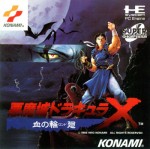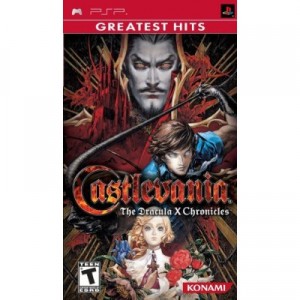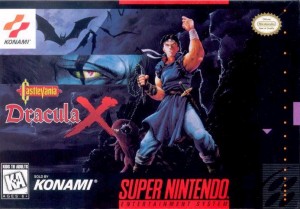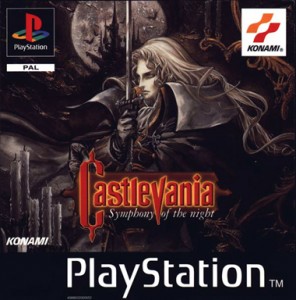$20 Game of the Week and Lost Classics Special: Dracula X
by William Talley, filed in $20 Game Of The Week, Games, Lost Classics on Oct.28, 2008
 Halloween is this week, so this week’s $20 GOTW and Lost Classics is dedicated to gaming’s original frightfest, Castlevania. More specifically, I’ll be looking at one of the franchise’s most prolific installments, Dracula X. Dracula has once again been revived, and it’s up to Richter Belmont, the latest in the line of the vampire hunting Belmont family, to destroy him. This time the stakes are higher, as Drac has kidnapped several maidens from the nearby village. Among them are Richter’s fiancee Anette, and her sister Maria. Dracula X was notable for it’s bright and crisp graphics, CD-quality audio, multiple routes through the levels, multiple endings, and the ability to play as a second character (Maria). However, despite being its critical acclaim amongst fans and reviewers, the Super CD title never saw a release outside of Japan until recently. I’ll be looking at both the original game (by way of its PSP remake), and the Super Nintendo adaptation. Although more recent entries in the series (such as the recently released Order of Ecclesia) utilize Symphony of the Night’s non-linear RPG-styled action, the classic linear gameplay seen in Dracula X still holds up even after more than a decade.
Halloween is this week, so this week’s $20 GOTW and Lost Classics is dedicated to gaming’s original frightfest, Castlevania. More specifically, I’ll be looking at one of the franchise’s most prolific installments, Dracula X. Dracula has once again been revived, and it’s up to Richter Belmont, the latest in the line of the vampire hunting Belmont family, to destroy him. This time the stakes are higher, as Drac has kidnapped several maidens from the nearby village. Among them are Richter’s fiancee Anette, and her sister Maria. Dracula X was notable for it’s bright and crisp graphics, CD-quality audio, multiple routes through the levels, multiple endings, and the ability to play as a second character (Maria). However, despite being its critical acclaim amongst fans and reviewers, the Super CD title never saw a release outside of Japan until recently. I’ll be looking at both the original game (by way of its PSP remake), and the Super Nintendo adaptation. Although more recent entries in the series (such as the recently released Order of Ecclesia) utilize Symphony of the Night’s non-linear RPG-styled action, the classic linear gameplay seen in Dracula X still holds up even after more than a decade.
$20 Game of the Week: Castlevania – The Dracula X Chronicles (PSP)
 The Turbografx-16, or the PC Engine as it was known in Japan, was an incredible system for sure. It was also the first American console system to support a CD add-on. However, its major problem was the CD add-on’s high price point($399), it’s small library (thankfully the system had no region protection, so importers could play Japenese titles) and the lack of third party support (due mostly in part to Nintendo’s harsh licensing practices at the time). While NEC’s console was popular in Japan (lasting until 1999) the system would die a premature death in the US by 1993. As a result, several of the PC Engine’s more popular games, such as Konami’s Dracula X, were never released outside of Japan. The most North American gamers would see of the game is a Super Nintendo title that had very little similarities to the PC CD title they yearned for so badly. It would be 14 years and 3 console generations before American gamers would finally see a release of the PC Engine CD original.
The Turbografx-16, or the PC Engine as it was known in Japan, was an incredible system for sure. It was also the first American console system to support a CD add-on. However, its major problem was the CD add-on’s high price point($399), it’s small library (thankfully the system had no region protection, so importers could play Japenese titles) and the lack of third party support (due mostly in part to Nintendo’s harsh licensing practices at the time). While NEC’s console was popular in Japan (lasting until 1999) the system would die a premature death in the US by 1993. As a result, several of the PC Engine’s more popular games, such as Konami’s Dracula X, were never released outside of Japan. The most North American gamers would see of the game is a Super Nintendo title that had very little similarities to the PC CD title they yearned for so badly. It would be 14 years and 3 console generations before American gamers would finally see a release of the PC Engine CD original.
Last fall, Konami finally bought the ‘real’ Dracula X to US shores – in the form of a PSP remake. The graphics have been redone, the soundtrack has been remixed, some of the level layouts have been changed, and some new enemies have been added, but for the most part, this is the Castlevania game we’ve been waiting for for years. Want the original game? Don’t worry, it’s on here too, as one of the game’s many unlockables. As an added bonus, Symphony of the Night is also hidden on the disc. So how does the game play? Well, remember how Castlevania used to be before the games became SOTN clones? Well, that’s how this plays. Dracula X was the last Castlevania game which stuck to the linear level based format, although this entry brings in a few new twists. There are multiple paths through the stages, and there are several alternate levels. Rescuing the maidens yields items which help destroy certain barriers. Destroying these barriers is important to discovering alternate routes and getting the good ending. As in the PC Engine game, if you rescue Maria, you can choose to play as her. To say that she’s unique is an understatement. Maria utilizes some very unconventional methods of attack such as kittens, birds, turtles, and other sickeningly cute stuff. However, it’s quite powerful. Richter still uses the classic Castlevania arsenal, which means the boomerangs, knives, axes, and holy water still work as you remember. However, Richter can utilize a powered up version of the weapons, called the item crash. While the item crash uses more hearts than the weapons normally do, they can turn the tide of a battle. You’ll need every advantage you can get too, as this game is among the hardest in the series. Casual gamers may be turned off, but more masochistic gamers will gladly take the punishment. There isn’t much to the game after you complete the stages, but you can go back through and find the unlockables, including music tracks and a minigame.
Even though it utilizes 2.5-d polygon graphics, and even with all the new additions, Dracula X Chronicles brings back the old school style of Castlevania which hasn’t been seen since the 16-bit era. The new additions make the deal even sweeter. Weather you’re a fan of the series, a PSP owner starved for a new addition to their library, or just a classic game lover, you’ll want to pick up this disc.
Lost Classics: Dracula X (Super Nintendo)
 Lets rewind to 1995. The Super Nintendo was on its last legs, and 16-bit gamers were desperate for some action. So you can only imagine how pleased players were when rumors emerged that Konami would be making a new Castlevania game for Super Nintendo. Better yet, this game would be known as Dracula X! Finally, the PC Engine classic would make it over here, and on Super Nintendo no less…
Lets rewind to 1995. The Super Nintendo was on its last legs, and 16-bit gamers were desperate for some action. So you can only imagine how pleased players were when rumors emerged that Konami would be making a new Castlevania game for Super Nintendo. Better yet, this game would be known as Dracula X! Finally, the PC Engine classic would make it over here, and on Super Nintendo no less…
…Or so gamers thought. Their joy would be short lived, as in short time the other shoe dropped. While we would get a new Castlevania game called Dracula X, it wouldn’t be THE Dracula X gamers have waited for and shelled out huge amounts of money to import. Instead, we’d get a brand new game, while sharing a few similarities with Dracula X, was clearly NOT the game we had so desperately wished for. Yes, it contained the same basic plot and gameplay. Richter sets out to rescue both his fiancee and future sister-in-law from Dracula. However, it contained several differences from the original PC Engine game. Neither Shaft nor his ghost was nowhere to be found, the levels were different, and worst of all, there was no playable Maria. Even so, the game was still good in its own right. It featured mode 7 graphics, a bright color palette, alternate routes and endings, and a soundtrack which featured several tracks from the original PC Engine CD game. However, the game contained some poor level design, leading to a lot of frustrating platforming moments for gamers. Still, while it may have been a huge letdown in terms of getting the ‘real’ version of Dracula X, the SNES version holds it’s own as both a solid entry in the Castlevania series, and as a late era Super Nintendo title. Even so, it would have been much better received by gamers if the PC Engine version of Dracula X didn’t exist. Personally, my only real regret with this game is that Konami didn’t give the Super Nintendo new Contra and Gradius titles before the 16-bit system died off.
After Dracula X, Symphony of the Night was released on Playstation. Not only was it one of the best games on the system, but it bought the Castlevania series back to its former glory, and proved that 2-d gaming was still alive and well, even in the 32-bit polygon era. It’s RPG-like stat building served as inspiration for a majority of the games which followed it, particularly those on the Game Boy Advance and teh Nintendo DS. Even though the Metroid-inspired gameplay has yet to grow stale, fans everywhere long for a return to the franchise’s original linear format. It may be a long while before that day comes, but at least players can experience this lost chapter of the Belmont saga, and enjoy the classic gameplay that they remember from so long ago.


 PS3
PS3
 Famicom Dojo
Famicom Dojo KEEP PLAYING
KEEP PLAYING KEEP PLAYING: Rewind
KEEP PLAYING: Rewind Powet Toys
Powet Toys Powetcast
Powetcast Hitchhiker's Guide POWETcast
Hitchhiker's Guide POWETcast















